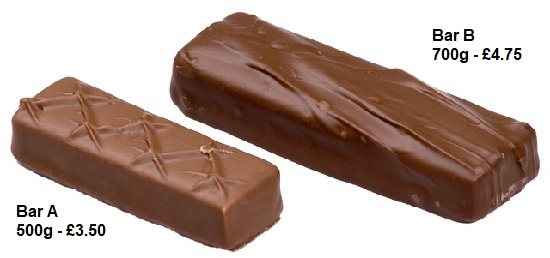Using Ratios to Calculate Best Value
There are many ways we can use ratios to calculate which items in the supermarket represent the best value. Supermarkets are notorious for finding ways to trick consumers into spending more money than they need to. Using ratios you can make sure that you don’t get caught out by their tricks.
Taking the chocolate bars below we can see that bar A costs £3.50 and bar B costs £4.75. Bar A is cheaper but is it the best value?

There are three main methods for calculating which bar offers the best value.
We can find the price for equal amounts, we can find out how much you get for an equal price and we can use common multiples.
Method 1 – Find a price for equal amounts
Bar A Bar B
500g costs £3.50 700g costs £4.75
100g costs 70p 100g costs 68p
Bar B is 2p cheaper per 100 grams.
Method 2 – Find out how much you get for an equal price
Bar A Bar B
£3.50 buys 500g £4.75 buys 700g
£1 buys 142.9g £1 buys 147.4g
£1 buys more with Bar B, so Bar B is cheaper.
Method 3 – Use common multiples
Bar A Bar B
500g costs £3.50 700g costs £4.75
x7 x5
3500g costs £24.50 3500g costs £23.75
Bar B is cheaper for equal amounts.
